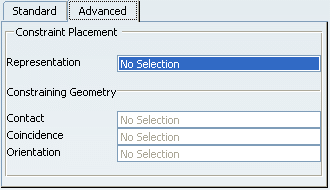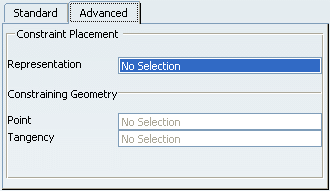All Connection Points Except Segment Connection
Points
You can place all connection points using multiple
constraints.
Click a connection point command.
In the dialog box that opens, select Advanced.

Select a geometrical element to represent the connection
point. You can, for example, select a pocket, a pad, a face, etc.
This element lets you visualize the connection point in
the geometry area and facilitates its identification while you
work.
In the example below, a face was selected.

Define one or more constraints depending on the degree
of freedom desired.
Valid geometry used to define the three degrees of freedom offered
is:
| Constraining
geometry
|
|
Valid geometry
|
|---|
| Contact
|
(obligatory) |
Surface or point |
| Coincidence |
(optional)
|
Surface, line or axis
|
| Orientation
|
(optional)
|
Surface, line or axis
|
Note: Orientation is used to constrain the rotation i.e. the third
degree of freedom.
The type of constraint obtained depends on the geometrical elements
selected for mating connection points.
For example, you obtain a contact constraint only if, for mating connection
points, the degree of freedom is defined by two surfaces in both cases.
If a point is selected, the constraint will be a coincidence constraint.
| |
Surface |
Point |
Line |
|---|
| Surface |
Contact
|
Coincidence |
Coincidence |
|---|
| Point |
Coincidence |
Coincidence
|
Coincidence |
|---|
|
Line
|
Coincidence
|
Coincidence
|
Coincidence
|
|---|
Click OK when done

Segment Connection Points
You can define segment connection points using the advanced method and set multiple
constraints.
Click Define Segment Connection Points. In the dialog box that opens, select Advanced.

Select a geometrical element to represent the connection
point. You can, for example, select a pocket, a pad, a face, etc.
This element lets you visualize the connection point in the geometry
area and facilitates its identification while you work. Set a Point constraint: select a point.
This point will possibly be used to identify the end of a segment. Set a Tangency constraint: select a plane
or an axis.
This plane or axis will possibly be used to orientate the segment. Click OK when done.
|